Frog: Morphology & Anatomy | Biology Class 11 - NEET PDF Download
| Table of contents |

|
| Introduction |

|
| Morphology of Frog |

|
| Anatomy of Frog |

|
| Uses: Benefits for Mankind |

|
Introduction
Frogs are animals that can live both on land and in freshwater. They belong to the class Amphibia within the phylum Chordata. The most common type of frog found in India is called Rana tigrina.
- Frogs are cold-blooded, which means their body temperature changes with the temperature of their environment.
- Frogs can change their color to blend in with their surroundings, which helps them hide from predators. This ability is called camouflage.
- When frogs are in tall grass, they might look different than when they are on dry land because of this color-changing ability.
- During very hot summers and cold winters, frogs go into deep burrows to protect themselves from extreme temperatures. This behavior is known as aestivation in summer and hibernation in winter.
Morphology of Frog
The skin of a frog is smooth and slippery because it is covered in mucus. This mucus keeps the skin moist. The dorsal side (the back) of the frog is usually olive green with dark irregular spots, while the ventral side (the belly) is a uniform pale yellow.
 Morphology of Frog
Morphology of Frog
- Frogs do not drink water like humans do; instead, they absorb it through their skin. Their bodies are divided into two main parts:
(a) The head
(b) The trunk. - Frogs do not have a neck or a tail.
- Above the mouth, frogs have a pair of nostrils. Their eyes are bulged out and protected by a nictitating membrane, which safeguards them when the frog is in water. On either side of the eyes, there is a membranous tympanum (ear) that helps the frog hear sounds.
- The forelimbs (front legs) and hind limbs (back legs) of a frog are used for swimming, walking, leaping, and burrowing. The hind limbs are larger and more muscular than the forelimbs. The hind limbs have five digits (toes), while the forelimbs have four digits. The feet of frogs have webbed digits, which assist them in swimming.
- Frogs also show sexual dimorphism, meaning male and female frogs have different characteristics. Male frogs can be recognized by the presence of vocal sacs that produce sound and a copulatory pad on the first digit of their forelimbs. These features are not found in female frogs.
Anatomy of Frog
The body cavity of frogs houses various organ systems, including the digestive, circulatory, respiratory, nervous, excretory, and reproductive systems, all of which are well-developed with specific structures and functions.
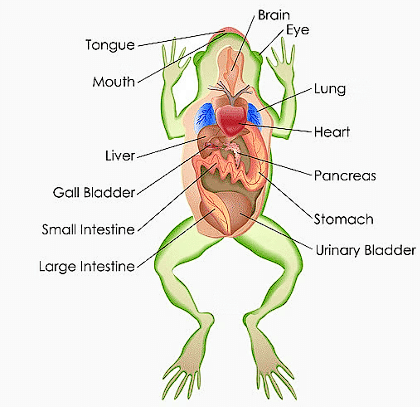
The body cavity of frogs contains several organ systems such as:
- Digestive system
- Respiratory system
- Circulatory system
- Excretory system
- Nervous system
- Reproductive system
1. Digestive system in Frogs
The digestive system comprises the alimentary canal and digestive glands. Frogs are carnivores, so their alimentary canal is relatively short. The process begins with the mouth opening into the buccal cavity, which leads to the esophagus through the pharynx.
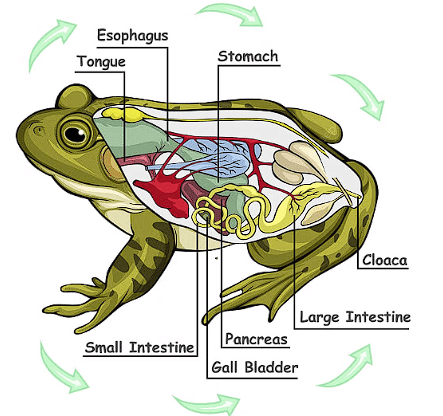
- The oesophagus is a short tube that connects to the stomach. From the stomach, the digestive tract continues as the intestine, and rectum, and finally opens to the outside through the cloaca.
- The process of digestion in organisms is a complex and vital function that involves the breakdown of food into smaller, absorbable components. It is essential for providing the necessary nutrients and energy required for various bodily functions. Let's explore the key aspects of digestion in a simplified manner.
Digestive Glands
- Liver: The liver plays a crucial role in the production of bile, a substance that aids in the digestion and absorption of fats. Bile is stored in the gallbladder until it is needed in the digestive process.
- Pancreas: The pancreas is another important digestive gland that produces pancreatic juice. This juice contains various digestive enzymes that help break down carbohydrates, proteins, and fats in the food.
Process of Digestion
- Tongue: The process of digestion begins when food is captured by the tongue, which is bilobed in some organisms. The tongue helps in manipulating the food and moving it towards the digestive tract.
- Stomach: In the stomach, the food is mixed with hydrochloric acid (HCl) and gastric juices secreted from the walls of the stomach. These substances help in breaking down the food further. The partially digested food, now called chyme, is passed from the stomach to the first part of the small intestine, known as the duodenum.
- Duodenum: The duodenum receives bile from the gallbladder and pancreatic juices from the pancreas through a common bile duct. Bile emulsifies fats, breaking them down into smaller droplets, while pancreatic juices digest carbohydrates and proteins. This is where a significant portion of digestion occurs.
- Small Intestine: The final stages of digestion take place in the small intestine. The inner wall of the intestine is lined with numerous finger-like folds called villi and microvilli. These structures increase the surface area for absorption and help in the absorption of digested food into the bloodstream.
- Rectum and Cloaca: The undigested solid waste that remains after the absorption of nutrients moves into the rectum and is eventually passed out of the body through the cloaca, an opening used for the excretion of waste.
This process of digestion is essential for ensuring that organisms receive the necessary nutrients and energy from the food they consume, allowing them to carry out various physiological functions and activities.
2. Respiration in Frogs
- In Water: Frogs breathe using their skin, a process known as cutaneous respiration. They absorb dissolved oxygen from the water through their skin by diffusion.

- On Land: Frogs use their buccal cavity, skin, and lungs to breathe. This type of respiration is called pulmonary respiration.
- Lungs: Frogs have a pair of elongated, pink, sac-like lungs located in the upper part of their body (thorax). Air enters through the nostrils, passes into the buccal cavity, and then into the lungs.
- Aestivation and Hibernation: During these periods, frogs can exchange gases through their skin.
3. Circulatory System in Frogs
- Closed Vascular System: Frogs have a well-developed closed vascular system consisting of the heart, blood vessels, and blood.
- Lymphatic System: Frogs also possess a lymphatic system made up of lymph, lymph channels, and lymph nodes.
- Heart Structure: The heart of a frog is a muscular organ located in the upper part of the body cavity. It has three chambers: two atria and one ventricle and is covered by a protective membrane called the pericardium.
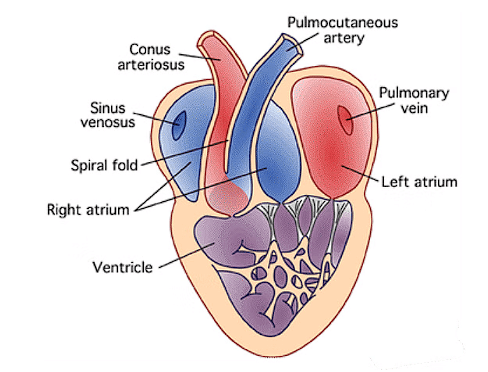
- Blood Flow: The right atrium receives blood from major veins called the vena cava. Blood from the heart is pumped into a sac-like structure called the conus arteriosus and then distributed to the body through arteries.
- Venous System: Veins collect blood from different parts of the body and return it to the heart. Frogs have special venous connections known as the hepatic portal system (between the liver and intestine) and the renal portal system (between the kidney and lower body).
- Blood Composition: Blood consists of plasma and cells, including red blood cells (RBCs), white blood cells (WBCs), and platelets. RBCs are nucleated and contain hemoglobin, which gives blood its red color.
- Lymph Composition: Lymph differs from blood in that it lacks certain proteins and RBCs.
- Functions of Blood: Blood carries nutrients, gases, and water to various parts of the body. Circulation is maintained by the pumping action of the heart.
4. Excretory System in Frogs
- The excretory system in frogs is responsible for eliminating nitrogenous wastes and consists of a pair of kidneys, ureters, cloaca, and urinary bladder.
- Kidneys: The kidneys are compact, dark red, and bean-shaped structures located posteriorly in the body cavity on either side of the vertebral column. Each kidney contains numerous functional units called uriniferous tubules or nephrons.
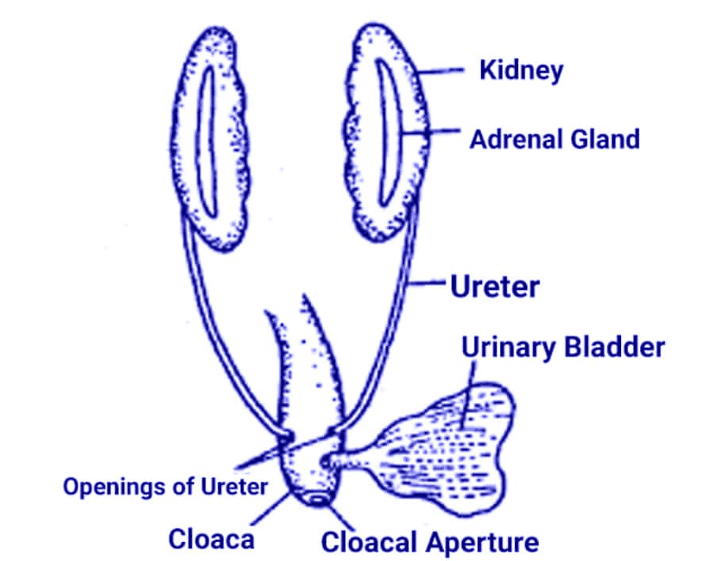
- Ureters: In male frogs, two ureters emerge from the kidneys. These ureters function as urinogenital ducts, opening into the cloaca. In female frogs, the ureters and oviduct open separately into the cloaca.
- Cloaca: The cloaca is a common opening for excretory and reproductive systems.
- Urinary Bladder: The thin-walled urinary bladder is situated ventral to the rectum and also opens into the cloaca.
- Excretory Process: Frogs excrete urea, making them ureotelic animals. Excretory wastes are transported by blood to the kidneys, where they are filtered and excreted.
5. Control and Coordination
Coordination in frogs is managed by the nervous and endocrine systems. The nervous system is responsible for quick responses, while the endocrine system handles slower, long-term changes through hormones.
Nervous System
- Made up of the brain, spinal cord, and nerves.
- The brain is protected by a bony case called the cranium and is divided into three parts:
- Fore-brain: Contains the olfactory lobes (smell), cerebral hemispheres (higher functions), and diencephalon (homeostasis).
- Mid-brain: Contains optic lobes for vision.
- Hind-brain: Includes the cerebellum (balance and coordination) and medulla oblongata (autonomic functions).
- The medulla oblongata connects to the spinal cord, which runs through the vertebral column.
- Nerves extend from the brain and spinal cord to the rest of the body, carrying signals.
Endocrine System
- Composed of various glands that secrete hormones directly into the bloodstream.
- Major glands in frogs include:
- Pituitary gland: Controls other glands and various bodily functions.
- Thyroid gland: Regulates metabolism.
- Parathyroid glands: Regulate calcium levels.
- Thymus gland: Involved in immune function.
- Pineal gland: Regulates circadian rhythms.
- Pancreatic islets: Regulate blood sugar levels.
- Adrenal glands: Produce hormones for stress response and metabolism.
- Gonads (ovaries and testes): Produce sex hormones and gametes.
Frog's Sense Organs
Frogs possess various types of sense organs, each specialized for different functions:
- Touch: Frogs have sensory papillae, which are organs of touch.
- Taste: Taste buds are responsible for the sense of taste.
- Smell: The nasal epithelium is the organ used for smelling.
- Vision: Frogs have well-organized eyes, which are simple in structure, consisting of only one unit. These spherical eyes are located in the orbit of the skull.
- Hearing: Frogs lack an external ear; instead, they have a tympanum, which is visible externally. The tympanum, along with the internal ears, functions as an organ of hearing and balance (equilibrium).
Eyes:
- Structure: Frog eyes are round and located in the skull's orbit.
- Type: They are simple eyes, meaning each eye has only one unit.
Ears:
- External Ear: The external ear is absent in frogs.
- Tympanum: The tympanum is the only visible part of the ear externally.
- Function: The ear serves both as an organ of hearing and for maintaining balance (equilibrium).
6. Reproductive Organs in Frog
(a) Male Reproductive System
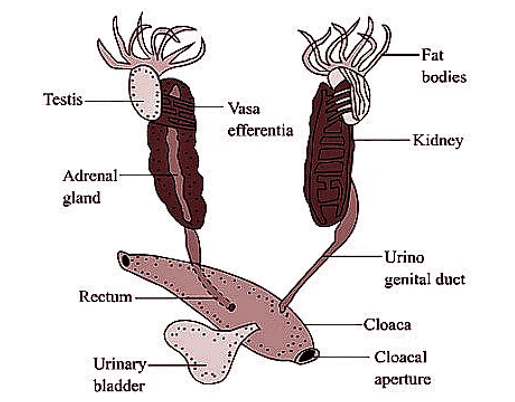
- Consists of a pair of yellowish ovoid testes attached to the kidneys by a fold of peritoneum called mesorchium.
- Testes produce sperm, which travel through 10-12 vasa efferentia into the kidneys.
- From the kidneys, sperm enter Bidder’s canal, which connects to the urinogenital duct.
- The urinogenital duct opens into the cloaca, a chamber that expels feces, urine, and sperm.
(b) Female Reproductive System

- Includes a pair of ovaries located near the kidneys, with no direct connection to them.
- Ovaries produce eggs that travel through the oviducts to the cloaca.
- A mature female can lay 2,500 to 3,000 eggs at once.
Fertilization and Development:
- Fertilization occurs externally in water.
- Development involves a larval stage called tadpole, which undergoes metamorphosis to become an adult frog.
Uses: Benefits for Mankind
- Insect Control and Crop Protection: Frogs play a crucial role in protecting crops by eating harmful insects. This natural pest control helps farmers and ensures a healthy food supply.
- Ecological Balance: Frogs are an important part of the food chain and food web. They help maintain ecological balance by serving as food for various predators, contributing to the overall health of the ecosystem.
- Human Consumption: In some countries, the muscular legs of frogs are considered a delicacy and are consumed by people as food.
|
150 videos|398 docs|136 tests
|
FAQs on Frog: Morphology & Anatomy - Biology Class 11 - NEET
| 1. What are the main external morphological features of a frog? |  |
| 2. How does the anatomy of a frog differ from that of a mammal? |  |
| 3. What are the ecological roles of frogs in their habitats? |  |
| 4. What are the benefits of studying frogs for medical research? |  |
| 5. How do frogs contribute to biodiversity and environmental health? |  |





















